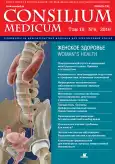Non-hormonal correction of vasomotor symptoms in peri - and postmenopausal women
- Authors: Levakov S.A1, Borovkova E.I1
-
Affiliations:
- I.M.Sechenov First Moscow State Medical University of the Ministry of Health of the Russian Federation
- Issue: Vol 18, No 6 (2016)
- Pages: 14-19
- Section: Articles
- URL: https://journals.rcsi.science/2075-1753/article/view/94472
- ID: 94472
Cite item
Full Text
Abstract
Full Text
##article.viewOnOriginalSite##About the authors
S. A Levakov
I.M.Sechenov First Moscow State Medical University of the Ministry of Health of the Russian Federationд-р мед. наук, проф., зав. каф. акушерства и гинекологии ИПО ГБОУ ВПО Первый МГМУ им. И.М.Сеченова 119991, Russian Federation, Moscow, ul. Trubetskaia, d. 8, str. 2
E. I Borovkova
I.M.Sechenov First Moscow State Medical University of the Ministry of Health of the Russian Federation
Email: katyanikitina@mail.ru
д-р мед. наук, проф. каф. акушерства и гинекологии ИПО ГБОУ ВПО Первый МГМУ им. И.М.Сеченова 119991, Russian Federation, Moscow, ul. Trubetskaia, d. 8, str. 2
References
- Randolph J.F.Jr, Sowers M, Bondarenko I et al. The relationship of longitudinal change in reproductive hormones and vasomotor symptoms during the menopausal transition. J Clin Endocrinol Metab 2005; 90: 6106.
- National Institutes of Health. National Institutes of Health State - of - the - Science Conference statement: management of menopause - related symptoms. Ann Intern Med 2005; 142: 1003.
- Thurston R.C, Joffe H. Vasomotor symptoms and menopause: findings from the Study of Women's Health across the Nation. Obstet Gynecol Clin North Am 2011; 38: 489.
- Soules M.R, Sherman S, Parrott E et al. Executive summary: Stages of Reproductive Aging Workshop (STRAW). Fertil Steril 2001; 76: 874.
- Huang A.J, Grady D, Jacoby V.L et al. Persistent hot flushes in older postmenopausal women. Arch Intern Med 2008; 168: 840.
- Rödström K, Bengtsson C, Lissner L et al. A longitudinal study of the treatment of hot flushes: the population study of women in Gothenburg during a quarter of a century. Menopause 2002; 9: 156.
- Freedman R.R. Physiology of hot flashes. Am J Hum Biol 2001; 13: 453.
- Freedman R.R, Roehrs T.A. Effects of REM sleep and ambient temperature on hot flash - induced sleep disturbance. Menopause 2006; 13: 576.
- de Zambotti M, Colrain I.M, Javitz H.S, Baker F.C. Magnitude of the impact of hot flashes on sleep in perimenopausal women. Fertil Steril 2014; 102: 1708.
- Ziaei S, Kazemnejad A, Zareai M. The effect of vitamin E on hot flashes in menopausal women. Gynecol Obstet Invest 2007; 64: 204.
- Newton K.M, Buist D.S, Keenan N.L et al. Use of alternative therapies for menopause symptoms: results of a population - based survey. Obstet Gynecol 2002; 100: 18.
- Keenan N.L, Mark S, Fugh-Berman A et al. Severity of menopausal symptoms and use of both conventional and complementary/alternative therapies. Menopause 2003; 10: 507.
- Kronenberg F, Fugh-Berman A. Complementary and alternative medicine for menopausal symptoms: a review of randomized, controlled trials. Ann Intern Med 2002; 137: 805.
- Van Patten C.L, Olivotto I.A, Chambers G.K et al. Effect of soy phytoestrogens on hot flashes in postmenopausal women with breast cancer: a randomized, controlled clinical trial. J Clin Oncol 2002; 20: 1449.
- Upmalis D.H, Lobo R, Bradley L et al. Vasomotor symptom relief by soy isoflavone extract tablets in postmenopausal women: a multicenter, double - blind, randomized, placebo - controlled study. Menopause 2000; 7: 236.
- Quella S.K, Loprinzi C.L, Barton D.L et al. Evaluation of soy phytoestrogens for the treatment of hot flashes in breast cancer survivors: A North Central Cancer Treatment Group Trial. J Clin Oncol 2000; 18: 1068.
- Nikander E, Kilkkinen A, Metsä-Heikkilä M et al. A randomized placebo - controlled crossover trial with phytoestrogens in treatment of menopause in breast cancer patients. Obstet Gynecol 2003; 101: 1213.
- Mac Gregor C.A, Canney P.A, Patterson G et al. A randomised double - blind controlled trial of oral soy supplements versus placebo for treatment of menopausal symptoms in patients with early breast cancer. Eur J Cancer 2005; 41: 708.
- Levis S, Strickman-Stein N, Ganjei-Azar P et al. Soy isoflavones in the prevention of menopausal bone loss and menopausal symptoms: a randomized, double - blind trial. Arch Intern Med 2011; 171: 1363.
- Frei-Kleiner S, Schaffner W, Rahlfs V.W et al. Cimicifugaracemosa dried ethanolic extract in menopausal disorders: a double - blind placebo - controlled clinical trial. Maturitas 2005; 51: 397.
- Osmers R, Friede M, Liske E et al. Efficacy and safety of isopropanolic black cohosh extract for climacteric symptoms. Obstet Gynecol 2005; 105: 1074.
- Verhoeven M.O, van der Mooren M.J, van de Weijer P.H et al. Effect of a combination of isoflavones and Actaearacemosa Linnaeus on climacteric symptoms in healthy symptomatic perimenopausal women: a 12 - week randomized, placebo - controlled, double - blind study. Menopause 2005; 12: 412.
- Pockaj B.A, Gallagher J.G, Loprinzi C.L et al. Phase III double - blind, randomized, placebo - controlled crossover trial of black cohosh in the management of hot flashes: NCCTG Trial N01CC1. J Clin Oncol 2006; 24: 2836.
- Newton K.M, Reed S.D, La Croix A.Z et al. Treatment of vasomotor symptoms of menopause with black cohosh, multibotanicals, soy, hormone therapy, or placebo: a randomized trial. Ann Intern Med 2006; 145: 869.
Supplementary files






